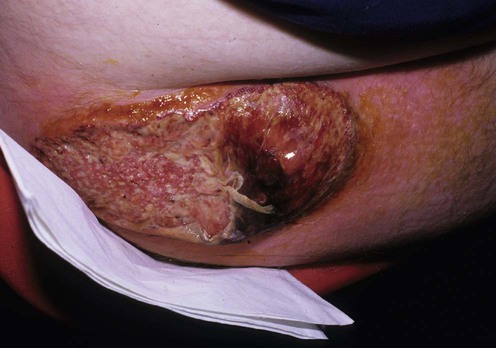Pyoderma gangrenosum

First-line therapies
Second-line therapies
Third-line therapies
Targeted treatment of pyoderma gangrenosum in PAPA (pyogenic arthritis, pyoderma gangrenosum and acne) syndrome with the recombinant human interleukin-1 receptor antagonist anakinra.
Brenner M, Ruzicka T, Plewig G, Thomas P, Herzer P. Br J Dermatol 2009; 161: 1199–201.
A single case of PG associated with an autosomal dominant genodermatosis.
A case of PG associated with inflammatory bowel disease has been reported not to respond.






 Topical tacrolimus
Topical tacrolimus Topical corticoids
Topical corticoids Dapsone
Dapsone Intralesional corticoids
Intralesional corticoids Minocycline
Minocycline Nicotine
Nicotine Topical pimecrolimus
Topical pimecrolimus Sodium cromoglycate
Sodium cromoglycate Sulfasalazine
Sulfasalazine Cyclosporine
Cyclosporine Systemic corticoids
Systemic corticoids Infliximab
Infliximab Other TNFα-antagonists
Other TNFα-antagonists Alefacept
Alefacept Alkylating agents (cyclophosphamide, chlorambucil)
Alkylating agents (cyclophosphamide, chlorambucil) Plasmapheresis (plasma exchange)
Plasmapheresis (plasma exchange) Leukocytapheresis
Leukocytapheresis IVIG
IVIG Intralesional cyclosporine
Intralesional cyclosporine Tacrolimus (FK506)
Tacrolimus (FK506) Azathioprine or mercaptopurine
Azathioprine or mercaptopurine Colchicine
Colchicine Thalidomide
Thalidomide Potassium iodide
Potassium iodide Topical nitrogen mustard (mechlorethamine)
Topical nitrogen mustard (mechlorethamine) Mycophenolate mofetil
Mycophenolate mofetil GM-CSF
GM-CSF Methotrexate
Methotrexate Topical platelet-derived growth factor
Topical platelet-derived growth factor Recombinant human epidermal growth factor
Recombinant human epidermal growth factor Clofazimine
Clofazimine Hyperbaric oxygen
Hyperbaric oxygen Isotretinoin
Isotretinoin Anakinra
Anakinra Ustekinumab
Ustekinumab Imiquimod
Imiquimod Visilizumab
Visilizumab Topical phenytoin
Topical phenytoin Surgical repair by graft or flap
Surgical repair by graft or flap